This part of the body of work which I present as a separate blog started in September 2022 and will be ongoing by the time of the final Assessment date I need to comply with. (15 October 2022)
I present it as a form of documentation about how my understanding of my making developed in the final stages of collaborative space and work. By now both of us (Annette Holtkamp and me) discovered new learning about materials as well as about the process of collaborating and working over a physical distance. We discovered that we prefer to work and make in an environment where cooperation, rather than conflict and competition, exist. We learned about mutual benefits and taking care of the work (each other’s) and process. Fungi as decomposers were the rationale behind our decision to bring our work together in a physical space and then decompose it.
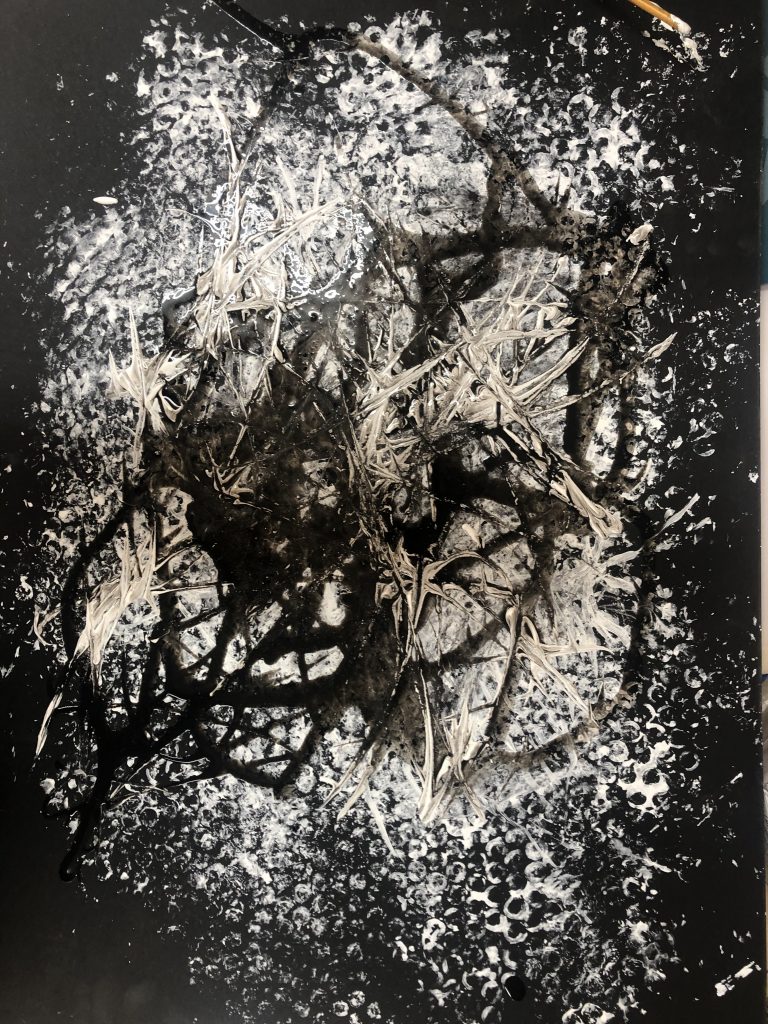
In my mind’s eye, I see the works I made of mycelium in my Parallel Project, using their hyphae, which act like root nodes to break down our work. (see fig. 1 above as that envisioned happening) Will these ‘unseeable’ hyphae find the spores and locate them in our material? Looking at this process as a time-based installation – a cycle of decomposition is what we could look back onto. I know I will be left with mushroom compost which is beneficial for soil drainage and it will contain spores which at the right time might sprout mushrooms again. Then there are the photo and video footage I am still involved with, but considering the potential in the bigger picture, I look at time in the process of making and working. There can be so much more to unfold in this involvement and collaborative explorations.
From Sheldrake (2020:201) in the chapter, he calls Radical Mycology, came the inspiration to consider how we could think differently about our making. Words such as fermentation, decomposition, symbioses, and radical came to the front. It took time for us to make a collaborative work and it will take time to take it to this next envisioned part. I think it important to stand still for a moment with the word,’ radical’, as Sheldrake (2020;200) so eloquently described and use in his writing. The word originates from the Latin word, radix, which means root. Sheldrake uses a literal interpretation and refers to the mycelial base or the grassroots of mycology. It is about change which comes from the roots, I am learning about. As an amateur mycologist, I could get my head into a hard-to-understand knowledge about the fungal world. It was self-taught mycologists (amateurs like Peter Mc Coy, Terence McKenna and Paul Staments) who really got into growing mushrooms on mostly agricultural waste, and proved it a win for cultivating fungi. I was inspired by this and learned here that oyster mushroom is omnivorous in the way they combust enzymes of agricultural waste, and produce healthy edible mushrooms. I learned about ‘training’ Pleurotus mycelium (oyster) to digest cigarette butt (2020:202). It seems we can learn with fungi how to clean up the mess we have created in many ways when it comes to pollution. Their history over time has shown that some fungi even thrived during calamitous episodes of the earth’s history.
Our idea is that mushrooms should consume the work – decomposing became an option where we wanted to take our learning and collaboration. (I explored the idea earlier by using a mushroom-growing medium and placing a small print of our work onto it. It became clear that by keeping the conditions as humid as possible we could see mushrooms consuming the work, as it was mainly paper and natural ingredients like flour, it would be exposed to.)
Below is an image that was taken on 13 September 2022 when the work was placed onto the growing substrate and the process of decomposition was activated. The intention was that I will intervene at stages of the process: I will protect the work from direct sunlight to get mycelium growing and try and control humidity. There are many factors I will not be able to control which have to do with the weather and soil conditions. I might not be able to control contamination as well, which will influence how mycelium will grow. I might add more spores to encourage mycelium growth.
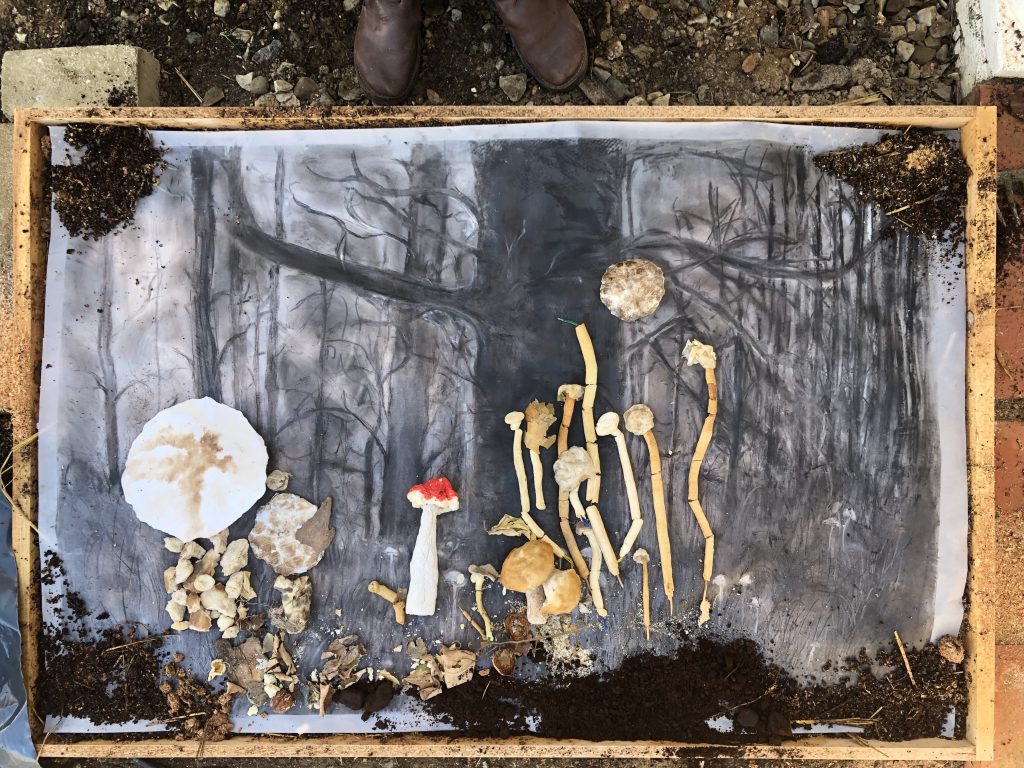
The process of decomposing the work started on 13 September 2022, when Annette Holtkamp’s work was placed onto my drawing. Our work, Involution, was now in one physical space. I became aware that the passage of time came to be part of this next process, which will focus on decay and the role mushrooms can play. I used harvested spore of mostly Pleurotus mushrooms, which I cultivated, and added to the growing medium before I placed our work on top of it. The growing medium consists of wood shavings from my husband’s carpentry workshop and coffee grounds I collected from a friend’s coffee shop. The drawing work was pierced with holes in order to let mushrooms pin through it and hopefully consume the work.
I made the wooden frame into which the work was placed with the help of my husband. A few weeks into the process we made another frame to cover the work and used a meshed fabric for it to be breathable and transparent. I am still keeping a black cover sheet over the work in the hope for more mycelium to grow.
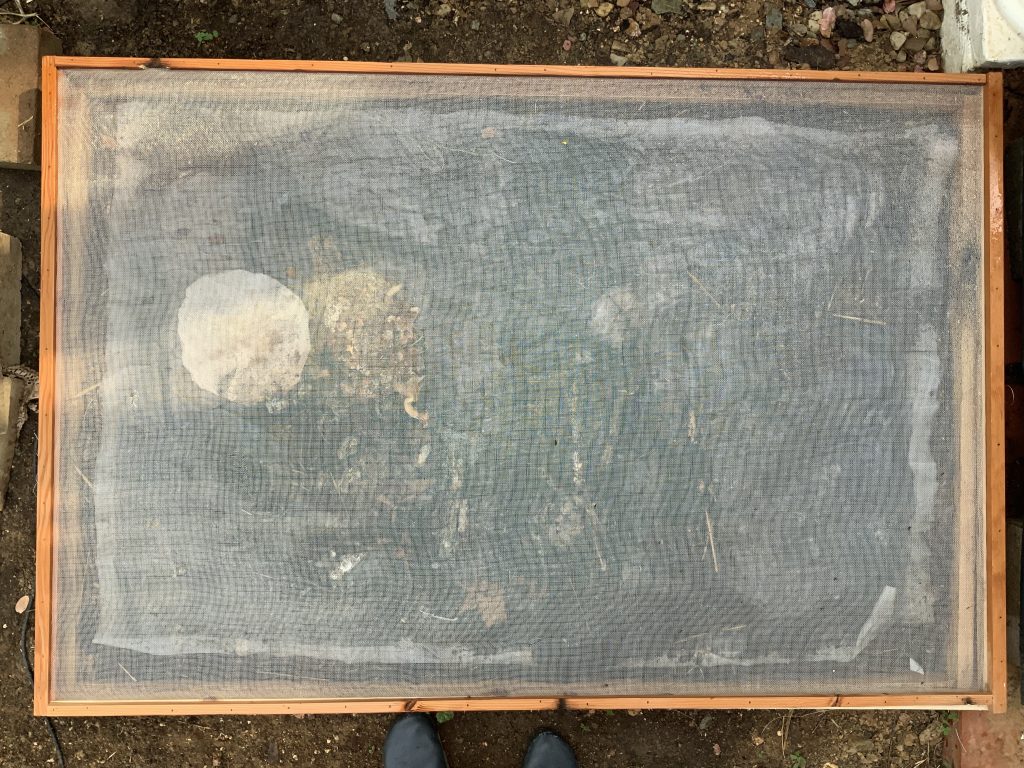
For a discussion around our collaboration as part of our WWW exhibition project, I made a short video which shows images of how our work started and grew into the current project. This video can be viewed on YouTube:
By 22 September two small mushrooms started to pin under one of the objects Annette contributed. It was getting warmer and I had concerns about the conditions not being ideal for these mushrooms to grow – they did not last very long, within 48 they showed no further growth and were drying. I am reminding myself that at least this is an indication of mycelium growing in the medium on which the work is laying and the cycle of growth of mushrooms is taking place. One can see in the second image that there developed more growth – I have no idea if it is mycelium or other fungi. My main concern is now how to deal with the warmer climate and contaminants in the air. I decided to consider place in this situation as a space in which I cannot control either the weather or air and need to sit this process out. Wind and heat are becoming concerns. I constantly need to check on the black plastic sheet which covers the work and decided to make a cover. The idea that it should be transparent is considered and I finally decide to use the thin wire mesh we have used for bug control on our windows. I need my husband to help to make a frame and we can only do this later in the month as he was travelling for work.
I recently started reading Matters of Care by Maria Puig De La Bellacasa and asking myself about my entanglement with fungi and how care has become part of my making practice. I need to think with care about how I continue this project. I ask myself if it is becoming performance work. I do like that most of my photos show my hands or feet, or one can hear my voice – my involvement, busy working with the fungi. De La Bellacasa shares a definition of care by Tronto: “….everything that we do to maintain, continue and repair ‘our world’…..which we seek to interveawe in complex, life-sustaining web.“(2017: 69)
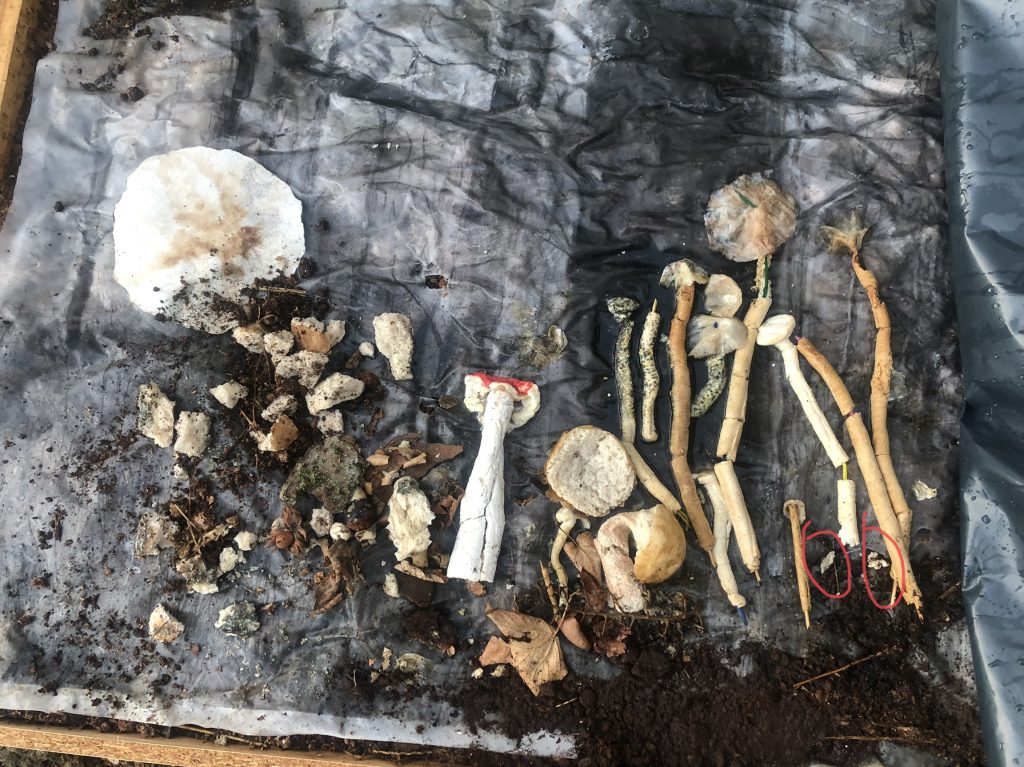
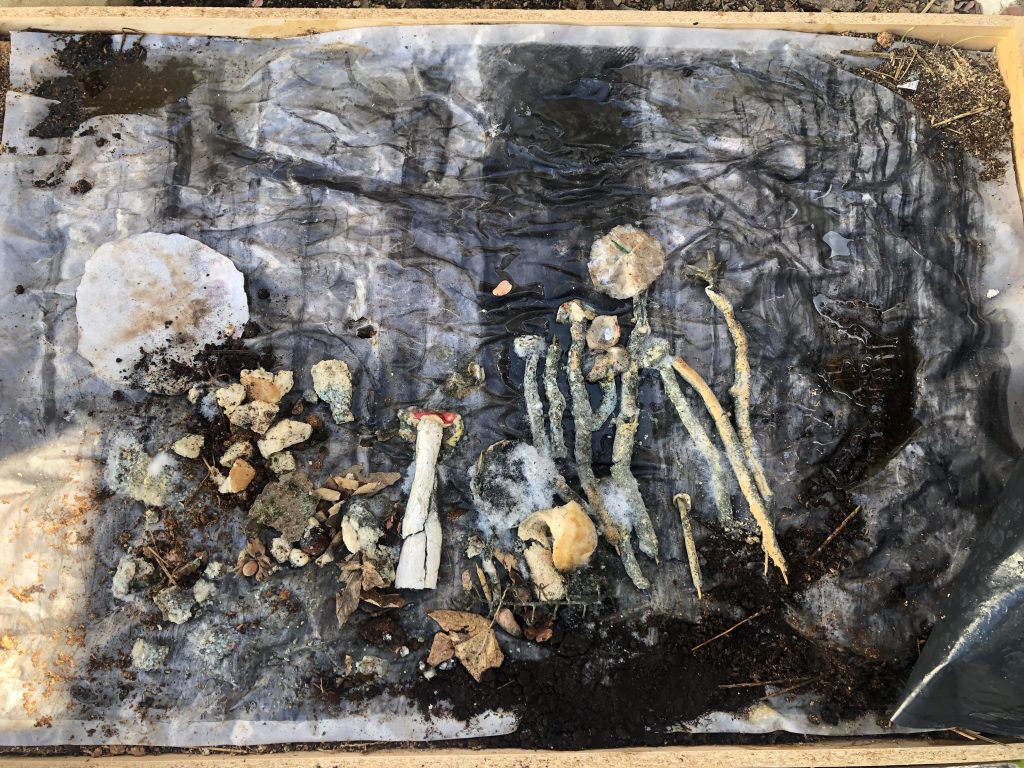
On 3 October 2022, I add a 3d work of a face I experimented with, to our decomposing work. My reason for doing this was that it was oyster mushrooms and their mycelium was still alive and could benefit the decomposing process. The mushrooms could also still drop spores and mycelium could grow onto the work and medium below. On the paper it was lying there were a lot of spores and I left it on the work to decompose alongside.
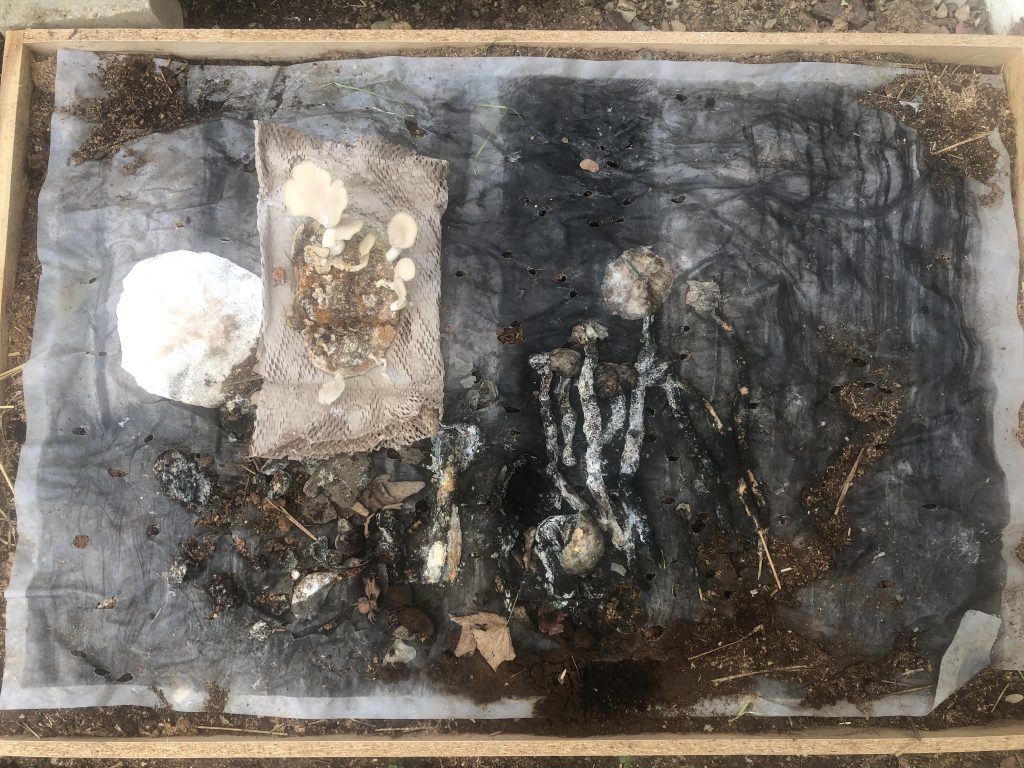
On Saturday 8 October 2022, I discovered two new mushrooms growing on/in (?) the work. These were new mushrooms I could add to my growing list of mushrooms I have identified. They are called Hare’s Foot Ink Caps. They have a thin white, tube-like stem with a very delicate cap, from which black ink was clearly dripping. They are also known as Wooly inkcaps and their scientific name is Coprinopsis lagopus. Lago means a hare and pous means foot. When I tried to touch the one, I broke its stem and decided to keep it and use it to make ink. Thereafter I learned that they only live for 24 hours. I hope that I could possibly ‘harvest’ spores as well as use the ink for more making. (now in the fridge, in a sealed bottle) The fruitbodies (mushroom) I have captured below, has been going through their entire visible lifecycle in a very short period. I am again learning from mushrooms, to look at what I am seeing in these beautiful forms. Here a very short metamorphosis happened, and I was fortunate to see a small part of it and use the ink in a small gestural drawing.
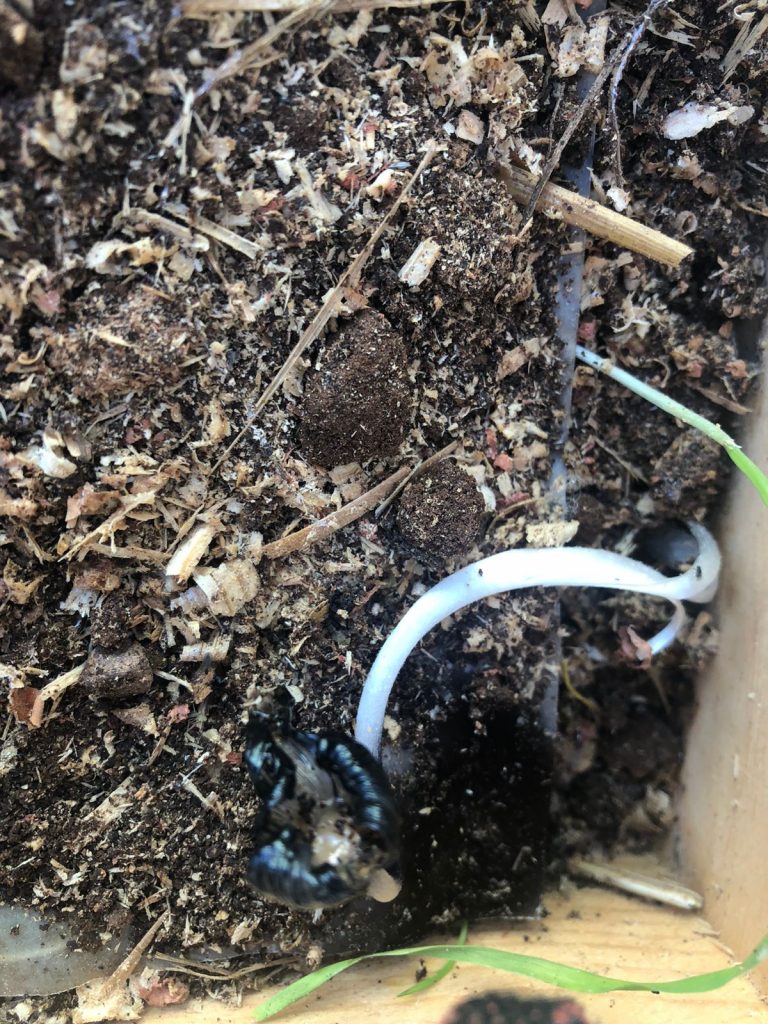
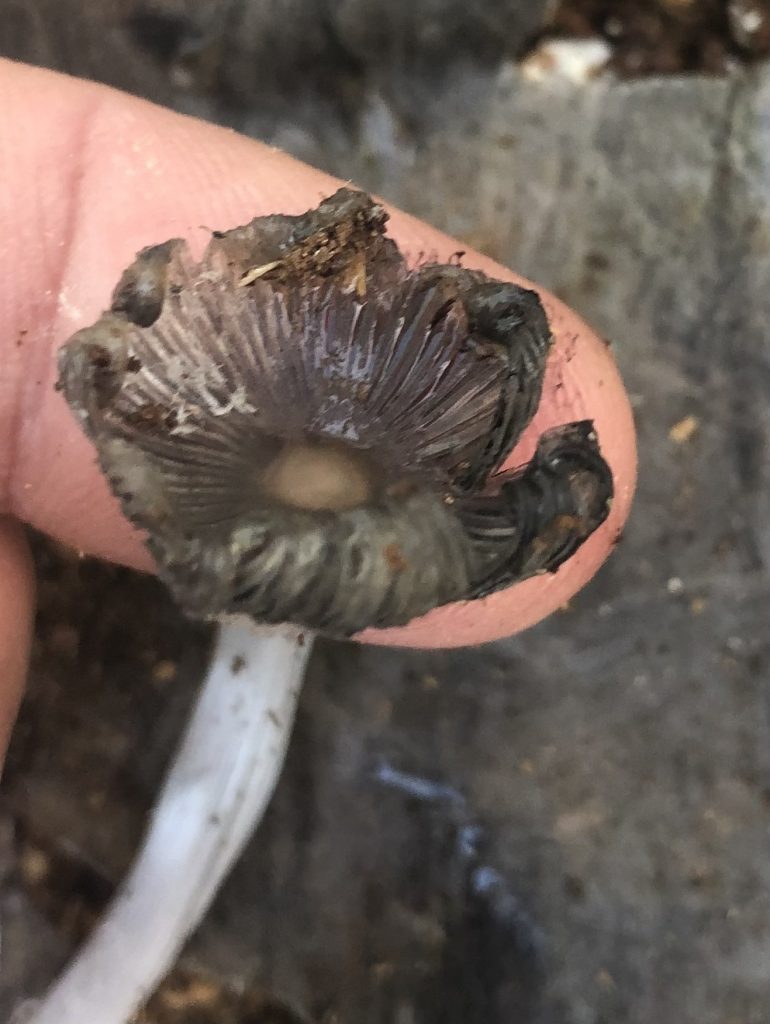

I made a drawing with the ink and Harefoot Mushroom in my sketchbook.
Later in my pocketbook about mushrooms, I read that this mushroom is rare in our area and mostly found in leave-litter, humous rich soil in shady woods. They are increasingly seen on woodchip mulch according to the ‘first-nature.com’ website I consulted. I also read that they are known as decomposers of wood and other organic material. This is good news for our work.
I discovered another Hare Foot Inky Cap on Monday 10 October 2022 and left it on the work. A few hours later I could see it almost completely disintegrated into the work.
I added more oyster mushroom spores to the work on 10 October 2022. It was a humid and windy day and I attempted in keeping the work moist under its black plastic cover. This repeated attention to the work means maintenance work – checking regularly that the work does not look too dry and spraying it with water at least every 4 hours.
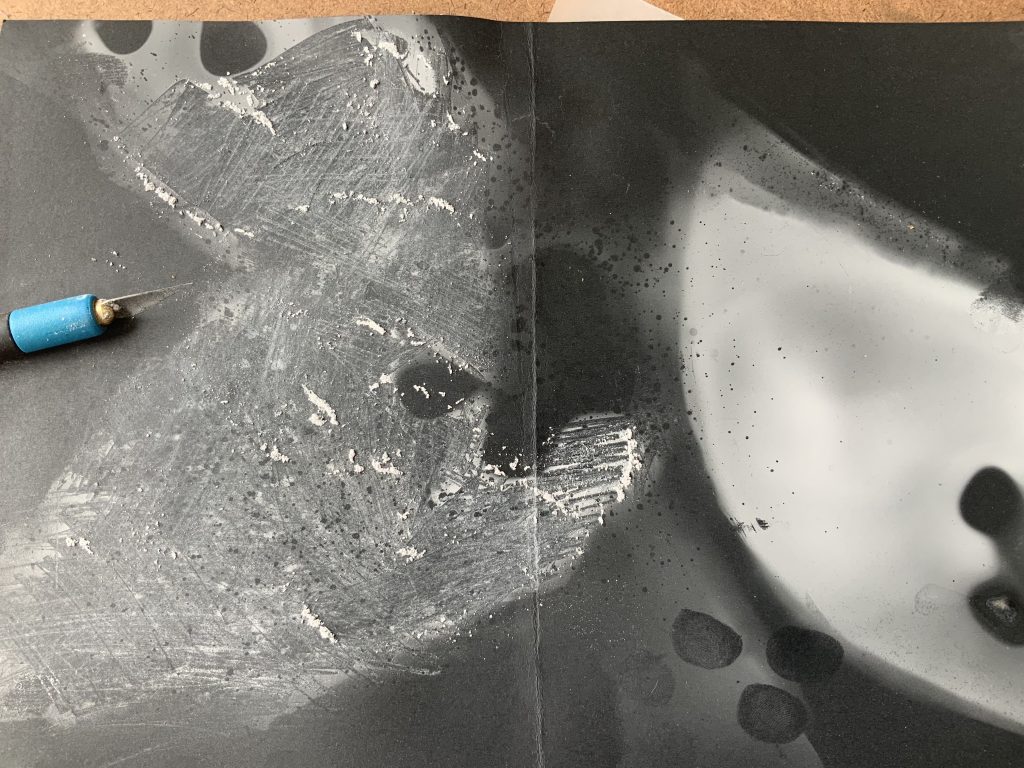
Reflecting on this work
n the Whitechapel Gallery documents of Contemporary Art, in the book, Materiality I read about Dan Graham (p175). Reading more about the artist, I think I take away the following to consider: objects can be identified with the space they are placed in, but, can they be viewed subjectively? I think I understand in this work the object lying under the cover in my garden, has now also become a tactile site of an experience I am sharing and also learning from. From working with mushrooms as material I am constantly aware of decay and growth, life and death, beginning and end. I learned about collaboration with the other, about interconnectedness with nature and that I thrive within this space of beauty and generosity. I see this work as a form of collaboration with nature and how over time our making will dissolve and become something ephemeral.
List of Illustrations
Fig. 1 Stander, K. (2021) Monochrome Entanglements. [Ink, Acrylic, Charcoal on Blackboard paper support] In possession of: the author: Langvlei, Riebeek West.
Fig. 2 Holtkamp, A & Stander, K. (2022) Involution: Fungi, Forests and Humans Installation [Charcoal drawing on velour paper, yeast, pastry dough, egg white, paper mache, silk noil, hazelnut ink] In possession of: the author: Langvlei, Riebeeck West.
Fig. 3 Stander, K. (2022) Cover made for Installation work [Photograph] In possession of: the author: Langvlei, Riebeeck West.
Fig. 4 Involution: Fungi, Forests and Humans
Fig. 5 Stander, K. (2022) Mushrooms pinning on the installation [Photograph] In possession of: the author: Langvlei, Riebeek West.
Fig. 6 Stander, K. (2022) Fungi growing on the installation [Photograph] In possession of: the author: Langvlei, Riebeek West.
Fig. 7 Stander, K. (2022) Documentation of installation [Photograph] In possession of: the author: Langvlei, Riebeek West.
Fig. 8 Stander, K. (2022) Coprinopsis lagopus [Photograph] In possession of: the author: Langvlei, Riebeek West.
Fig. 9 Stander, K. (2022) Coprinopsis lagopus fruitbody [Photograph] In possession of: the author: Langvlei, Riebeeck West.
Fig. 10 Stander, K. (2022) Third Coprinopsis lagopus found on Involultion Intallation [Photograph] In possession of: the author: Langvlei, Riebeeck West.
Fig. 11 Stander, K. (2022) Drawing with fungi [Video] In possession of: the author: Langvlei, Riebeek West.
Fig. 12 Stander, K. (2022) Spores scraped off paper [Photograph] In possession of: the author: Langvlei, Riebeek West.
Bibliography
de la Bellacass, Puig 2017 Matter of Care University of Minnesota Press Accessed on SCRIBD as e-book. pp 69-70.
Branch,M. Levin H. Mitchell D. Rappopart S (1987) A Field Guide to the Mushrooms of South Africa (2nd ed) Stuik House, Cape Town. pp 70-73.
Inky Cap Mushrooms. First Nature website At: https://www.first-nature.com/fungi/coprinopsis-lagopus.php (Accessed online on 08/10/2022)
Lange-Berndt P. (2015) Materiality: Documents of Contemporary Art. Whitechapel Gallery, London.
Sheldrake, Merlin. 2020 Entangled Life: How Fungi make our worlds, change our minds, and shape our futures Vintage Books, Penguin Random House UK.